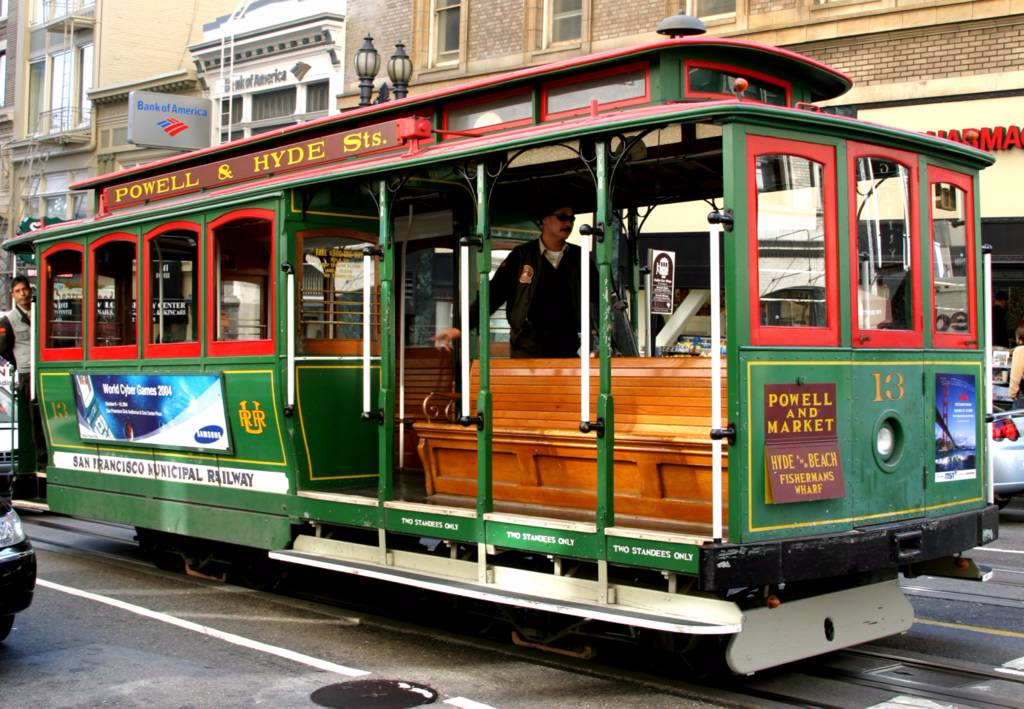San Francisco Bay Guardian, 2002-09-04, v36-n49 - 49pge
The $620 million shakedown
PG&E's high rates are damaging San Francisco's economy — but public power could turn things around. By Tim Redmond and Savannah Blackwell
Soaring rate hikes by Pacific Gas and Electric Co. have taken as much as $620 million a year out of the San Francisco economy, significantly worsening the impacts of the recession and slowing the recovery, a Bay Guardian analysis shows. And replacing PG&E with public power could potentially pump $550 million into the economy.
The analysis, based on methodology developed by an economics professor at Long Island's Hofstra University, provides a powerful new argument in favor of public power and contradicts the position taken by many business groups in the city, which have lined up in support of PG&E and in opposition to the public power measure on the November ballot.
The outcome is no surprise to public power advocates. “There are literally hundreds of examples all over the country of how public power has helped local economies," Deborah Penn, vice president of information services at the American Public Power Association (APPA) in Washington, D.C., told us. "The overall sense of it is that when you have lower rates, the citizens in the community have more money to spend on other goods." Mike Bell, senior director at R.W. Beck, a Sacramento utility consulting firm, said that typically lower rates of public power companies attract new businesses to the neighboring communities.
"Many of the public power systems use these lower rates as an incentive to economic development, and they actively use it in marketing and bringing in new business," Bell said.
PG&E's rate hikes, on the other hand, have hurt San Francisco's economy, Bell said. "The higher the cost of electricity service, the higher the expense for running and operating a company. Their recent hikes have created hardships for small businesses" (see "Feeling the Crunch," page 25).
Long Island's a winner
Like every area in the New York metropolitan region, Nassau and Suffolk Counties, on Long Island, were hit hard by the recession and the Sept. 11 attacks. But the two counties, adjacent to New York City, recovered a lot faster than the city itself: unemployment in Nassau and Suffolk is only 4.2 percent today, compared with 7.7 percent in New York City and 6 percent nationwide.
Consumer spending is up in the region: sales tax revenues to the local government are up 4.5 percent over last April.
What does Long Island have that Manhattan and the Bronx don't? Public power.
Electricity rates in the two Long Island counties — which get their electricity from the public Long Island Power Authority — have dropped 20 percent in the past four years, while Con Edison, the private utility that supplies New York City, raised rates as much as 40 percent over the past year.
According to Irwin Kellner, an economics professor at Hofstra University and the chief economist for CBS's Marketwatch.com, the cut in LIPA rates has been a major cause of the relative economic prosperity in eastern Long Island. LIPA's rate cut "has helped Long Island stave off the effects of a national recession and the terrible events of Sept. 11," Kellner concluded in a study on the issue.
In fact, Kellner noted, LIPA's rate cuts have injected $2 billion into the Long Island economy since the public power agency was formed four years ago — and that has had a huge ripple effect, expanding the region's economy by $10 billion.
"When consumers have lower rates for a necessity like electricity, they tend to spend the extra money in a way that helps the local economy," Kellner told us.
The reverse is also true — and Kellner's analysis, applied to San Francisco and to northern California, shows that the local and regional economies have taken a sizable hit from PG&E's 40 percent rate hikes over the past three years.
It works here, too
Although Kellner hasn't looked at the figures for PG&E and San Francisco — and hasn't reviewed or approved our analysis — he told us that it's fair to apply his reasoning to the local situation. "It's reasonable to state, in general, that when the price of a necessity goes up, it has a negative impact on consumer spending. And since we are a consumer-driven economy, that has an impact on jobs and the economy as a whole."
Kellner's methodology was relatively simple. He took the total reduction in LIPA electric rates ($2 billion over four years), and, based on standard macroeconomic assumptions, multiplied it by five to account for what economists call the "multiplier effect." In essence, he argued that every dollar consumers saved on their utility bill was money that would be spent on other goods and services — mostly in the local community. That means that a dollar a LIPA customer spent on beer at a corner store became a dollar the shopkeeper could spend on shoes for her kids, which became a dollar the shoe-store owner could spend at a local restaurant, etc.
Economists constantly argue about the exact value to put on the multiplier effect — it's reduced, for example, if the money goes into savings or to buy imports. But Kellner, a former chief economist for Manufacturers Hanover Trust in New York City, says that his figure makes sense for a regional economy like Long Island's — or the Bay Area's.
San Francisco businesses and residents spent $557 million on electricity in 2001, according to the latest figures available from the City Controller's Office. That was up $124 million from 1999 — about a 28 percent increase. (PG&E's rates went up about 40 percent statewide over the same two-year period, according to the Utility Reform Network (TURN), but many businesses and residents cut back on use.)
Using Kellner's multiplier, that $124 million amounted to a $620 million hit on the economy — money that went to PG&E and, for the most part, got sucked out of town.
PG&E argues, of course, that it also contributes to the economy and that money paid to PG&E has a positive impact on economic activity. And, indeed, the money PG&E collects goes in part to pay its workers, some of whom spend it in town to pay local vendors.
But with PG&E in bankruptcy, little of the rate increase the company has received has gone to increased hiring, for example, or increased spending on local goods. On the contrary: The company has been cutting its workforce. And PG&E shuffled $4.5 billion of our money off to its parent corporation right before its bankruptcy filing.
Matt Freedman, a staff attorney at TURN, said PG&E is currently setting aside much of its cash in a special slush fund that will be used to pay off big creditors — mainly out-of-town banks — at a later date. "We’ve found $2.67 billion they’ve collected between September 2001 and June 2002, above and beyond what they need for approved costs,” he said. “It's a staggering sum of money that's being stashed away for future debt payments — and that’s money that could have been going into the local economy."
And the rate increase certainly hasn't helped PG&E shareholders: the stock's value has plummeted in the past year.
So, while it would be unfair to say that every penny of that $620 million has vanished from the local economy, a substantial portion certainly has done so.
San Francisco households spent $75 million more on electricity for residential use in 2001 than they did in 1999, the controller's data shows. Using Kellner's multiplier, that's $375 million taken directly out of consumer spending
U.S. District Court judge Vaughn Walker's Aug. 30 decision paving the way for PG&E's bankruptcy plan to override the deal between the California Public Utilities Commission and the company's creditors likely means the 40 percent increase is here to stay. The CPUC is appealing Walker's decision. He is expected to choose one of the plans in November.
According to TURN, PG&E is seeking to stick its customers with another $18 billion to cover its debt and to protect its shareholders and CEOs from the possibility of any future losses (see the report "Highway Robbery" at www.turn.org).
On the positive side, R.W. Beck estimated in a report for San Francisco's Local Agency Formation Commission that most cities with public power offer rates 20 percent lower than those of privately owned utilities. A Bay Guardian study last year showed that the city could buy out PG&E and cut residential rates by 20 percent, with money to spare (see "MUD Money," 10/10/01). If that occurs, the rate cut could pump more than $550 million into the local economy, according to Kellner's methodology.
So, instead of losing $620 million to high PG&E rates, the city would gain $550 million.
If the experience of other public power cities holds, that would lead to significant job gains, among other benefits. APPA's Penn noted, for example, that the small Kansas town of McPherson, which has a public power system, has attracted nearly 50 new companies and is booming, despite the recession. For years McPherson officials have been able to use cheap electricity rates as a lure, according to an Aug. 23, 2001, article in the Wall Street Journal. "The public power system is focused on keeping jobs in the community," Penn said.
How it would work
Could San Francisco really see electric rates fall by 20 percent with public power? A study we did last year (published Oct. 10, 2001, and on the Web at www.sfbg.com/News/anniversary.html) — that nobody has successfully challenged — shows how it could happen.
If Proposition D passes in November, a newly constituted San Francisco Public Utilities Commission will have the authority to issue revenue bonds to build new power plants — and, if a study shows it's feasible, to take over PG&E's local facilities. The study would have to show that the city could buy out PG&E and still sell power for less than the private utility would be charging.
PG&E would fight bitterly to prevent a takeover of its lines, poles, meters, and general distribution system. The real issue would be the price San Francisco would have to pay for the system — and PG&E would fight for the highest possible price.
The PG&E-funded campaign against public power claims PG&E's system is worth more than $1 billion — and uses that figure as a scare tactic, suggesting that the city's taxpayers would be on the hook for that huge sum of money. But it's just not true.
A generally PG&E-friendly study that the city commissioned in 1996 concluded that the most likely figure for the price of a buyout was about $795 million (still a big number). We looked at what the state Board of Equalization, which assesses taxes on PG&E, thinks PG&E's property is worth, and got a much lower figure: about $528 million.
Either way, the city's taxpayers wouldn't be responsible for any of it — the entire cost would be covered by revenue bonds, which would be paid back from the money the city would make selling electricity. And, in fact, when we added up the numbers, we found that the revenue from power sales (even at rates 20 percent lower than PG&E was charging) would be more than enough to cover the payments on the revenue bonds, as well as the costs of operating the system (labor, maintenance, purchasing power, etc.)
One key reason the city could sell power cheaper: San Francisco wouldn't be paying multimillion-dollar salaries to top executives, wouldn't be funneling big bags of cash off to bolster a parent company's bottom line, and would have all sorts of tax and financing advantages as a public agency.
PG&E's latest argument against Prop. D is expected to be that the Aug. 30 passage of state assemblymember Carole Migden's bill allowing cities to apply for and use state money to develop renewable energy sources means the measure isn't needed.
But those dollars could not cover the cost of building new fossil-fuel, small combustion turbines that the city's top public power adviser, Ed Smeloff, says must be constructed in order to shut down the polluting Hunters Point power plant and make the planned expansion of Mirant's Potrero Hill power facility unnecessary (see "Powering Ahead," 8/21/02). Migden's bill would also allow cities to gather residents together into a single customer pool for the purchasing of electricity.
“A.B. 117 is a great achievement," Prop./ D. campaign manager Ross Mirkarimi said. “It is a referendum on deregulation, and it gives the green light to cities in California to pursue public power. But the cities won't be able to do that unless they pass their own local measures — such as [Prop. D]."
How LIPA works
The story of how LIPA was able to cut its rates for business and residential customers starts with a bad decision on the part of the area's previous private utility to build a huge nuclear power plant in the region in the late 1960s. The Shoreham nuclear power plant, initially projected to cost $700 million, wound up setting the now defunct Long Island Lighting Company back more than $6 billion. That huge debt was reflected in ever higher rates paid by local businesses and residents.
For years Long Island struggled with the highest electricity rates in the continental United States. Residents and business owners developed a seething hatred for their local privately owned utility. Complaints about the oppressive bills became part of the culture, according to Bert Cunningham, vice president of communications at LIPA and a Long Island native. Fixing the problem was at the top of the agenda for local politicians.
In 1986, New York governor Mario Cuomo and the state legislators representing Long Island pushed through a law creating LIPA. Under the plan, LIPA would take on the nearly $200 million price tag for closing down the Shoreham plant. LIPA's mandate? To lower rates and keep them as low as possible.
In 1998 LIPA acquired LILCO's transmission and distribution system and took over the responsibility for providing electricity to local residents and businesses. The deal was strongly supported by Long Island's business community, which was hoping to diversify and transform the local economy from one based on post–World War II cold war manufacturing into something more contemporary. Decades of crippling electricity rates had made that nearly impossible.
Roughly one year after the deal was announced, LIPA cut rates by 20 percent.
This was only possible because, as a publicly owned entity, LIPA was able to refinance LILCO's nuclear debt through the use of low-interest bonds. LILCO was paying 13 to 15 percent interest, but LIPA was able to get 5.7 percent interest rates on what had grown to be about a $7 billion debt.
Suddenly, a community with a dinosaur economy got a huge infusion of cash. Local businesses "got with the Internet economy," according to Cunningham. Public relations and advertising agencies started to thrive. The unemployment rate plummeted.
"It was a tremendous shot in the arm," Cunningham said. "For residents, the bills decreased about $240 a year on average. But the biggest boost came to local businesses. If you were spending $10,000 to $20,000 a month on electricity, and suddenly you get a 20 percent cut, that's a significant amount of money."
"There was also the psychological boost from seeing LILCO finally go out of business," he said. "Finally, the war between the consumers and the electric utility was over."
More than one million residents and businesses in Nassau, Suffolk, and the Rockaway portion of Queens benefit from the low rates. The utility has been able to spend a substantial amount of money on conservation and environmentally sound energy programs and has so dramatically improved its basic infrastructure that it's now the most reliable utility in New York State, according to the New York Public Service Commission.
Business opportunities are so good in Long Island now that it's no longer a bedroom community for workers in New York City.
"It's done a flip-flop," Cunningham said. "Now most of our people are living and working here."
When the price of fuel skyrocketed during 2000 and 2001, LIPA kept its rates steady, unlike private utilities throughout the country, then raised them just 5.8 percent. The reason? Because LIPA had cut rates, new businesses had opened, and the company had added more customers. So LIPA was ahead of schedule in making payments on the $7 billion Shoreham debt.
During the 2000–01 energy crisis LIPA's bill for the purchase of electricity rose by $500 million (it doesn't own any generating facilities). But instead of passing all of it on to its customers, the agency was able to absorb half of it, thanks to its favorable debt position.
Even the Republican governor of New York, George Pataki, is thrilled with public power's performance. "It's clear that the rate cut has helped Long Island's economy stave off the effects of the national recession and the severe damage caused to New York's economy by the terrible events of September 11," Pataki announced in a May 24 press conference lauding LIPA (his press statement and the Kellner report are on the Web at www.lipower.org/newscenter/pr/2002/may24_02.html).
Unlike PG&E, LIPA is a publicly owned utility that is not designed to make fat profits. When it has a good year, it simply rolls the money forward to keep rates low the next year. There are no shareholders to pay and no CEO salaries to pad. (PG&E Corp.'s brass, on the other hand, made off with $30 million in bonuses last year.) And LIPA isn't about to go bankrupt.
Local businesses are ecstatic. "When the deal was done to create the Long Island Power Authority, it was estimated that the savings would produce about $500 million in additional cash in the pockets of people of Long Island. That has proven to be true," Matthew Crosson, the president of the Long Island Association, a business group, told us. "The business community is quite pleased with the way this has worked out."
For more information on the benefits of Proposition D go to www.powertothepeople.org.
E-mail Tim Redmond at tredmond@sfbg.com.
E-mail Savannah Blackwell at savannah@sfbg.







